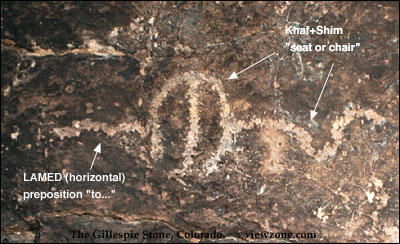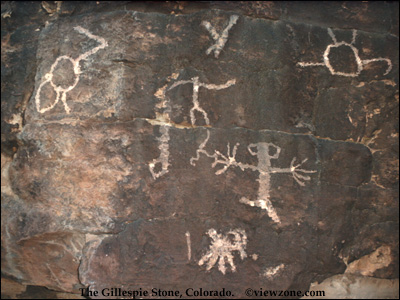|
A Preview of the Expedition's Discovery
Lee chose to name the important discovery after Rollin Gillespie, a remarkable scientist whose insight and intellect first stimulated our interest in American petroglyphs. It is now known as The Gillespie Stone. [N 37 38'13.53" / W 103 35'13.76"]
TRANSLATION: The upper left ligature has three letters. The yod and resh are immediately recognized, as well as a rare inclusion of the vowel aleph. This ligature reads yaRE, "fear, respect, to hold in awe..." See the old Negev alphabet and modern Hebrew equivalent. Also, remember that vowels are not usually written in old Negev. The top central ligature appears somewhat distorted because of the underlying rock topography. It reads as a he, "the, the one..." On the top right is the word for God, "El." It is written using the archaic form of the vowel aleph, which was also depicted as an animal head with two horns. The lamed remained largely unchanged from the archaic form to that of old Negev script. The entire top of this panel can thus be read, from left to right, as our modern equivalent to "praise to the one God," or quite simply, "Praise God." The central ligature that resembles a wishbone is actually a clever combination of letters written to graphically, as well as phonetically, convey its meaning. The main figure appears to be holding something in its right hand that ends in a circular shape. The object being held is actually a ligature read from the bottom up as A-S-S. Because the last two letters repeat, we will expect this to be a word-break (see Harris et. al.) and will read the ligature as "ESH" or "fire." The main figure is a ligature for lamed and he (rotated to indicate end of word or phrase). LH is " 'oLAH" or "burnt offering." The figure further down also appears to be holding something in its hand. On close inspection it is the letters RSS. Deleting the final S we read ROSH as "chief, leader, head..." The significance of the figure is, as yet, untranslated. The bottom of this panel contains the familiar horned ram symbol of "El" and is flanked by the letters (from left to right) LN, or to (lamed used as a preposition "to" or "for") pray... On the top of this photograph you can see a horizontal line which is actually the bottom of a flat step in the rock, which had a flat back to it which resembled a bench. There was no carving on this bench and so we did not focus attention on it. That was unfortunate. We later found the following inscription on the side of the same huge rock, directing the way to the "kee'sei", seat or chair...
 With hundreds of digital images and video to examine, translations are being made daily. We hope to display more of this work as it becomes available. We now have solid proof that a culture from the Sinai lived and grew in the middle of America thousands of years ago. There is evidence that other cultures also migrated to America from Asia, and that global navigation was no obstacle to antiquity. As always, viewzone welcomes your comments and questions.
Gary Vey, Editor June 2, 2006.
|
Background Information After the Expedition of '98, when we first saw these strange petroglyphs, ViewZone was anxious to return to Colorado to translate the petroglyphs using the recently discovered old Negev alphabet in combination with an old Hebrew lexicon. Our dreams became a reality in May of 2000 and the team assembled in La Junta, Colorado, equipped with all of the hi-tech tools that we could gather. La Junta, Colorado is a small town in the middle of the most remote part of the lower 48 states. Surrounded by miles of prairie, it's raison d'etre (a US Calvary outpost that guarded the sana Fe trail) was renewed by American's insatiable appetite for meat. La Junta is smack dab in the middle of "meat country." The railroad terminal and livestock auctions in La Junta are giant death camps for a variety of stock. Two of our team were vegetarians, which made for some awkward dining in local restaurants and even more awkward encounters with the cattle (one member, in particular, wanted to pet them). The country around La Junta is dry and sandy with many deep and rocky canyons. Most of the vast land is either privately owned or sublet from the government by huge cattle ranchers. If you accidentally cross one of their barbed-wire fences, you may consider yourself lucky to escape being shot. Cattle rustling and arrowhead hunters have caused most locals to be wary of strangers and guarded in revealing geographic information. Oddly, they seem completely unaware and uninterested in the archaeological significance of the petroglyphs. Many privately owned ancient sites are currently being trampled by herds of Herefords. Ted Barker, a local rancher who has devoted years to petroglyph research, negotiated for the ViewZone Expedition to gain access to many of the important, privately held sites containing examples of old Negev. The biggest surprise, however, was that many of the most intact and useful sites were located on the extremes of the National Grasslands area, a public park. With the evidence our crew discovered, there should be no doubt that a migratory group from the Sinai occupied America many hundreds of years BC. In fact, much of the old Negev script that we documented was itself written over much older, more crudely drawn, Negev script. We saw countless evidence of at least two eras of Negev-like symbols, as well as the Plains Indian scrapings and the latter so-called "cowboy art" from the traffic of the near by old Santa Fe Trail. While we await the scrutiny of the scholars to acknowledge our work, and to do their own research, we will continue translating and posting our material. We invite anyone with an interest to share in this exciting exploration of ancient history by using the translation program and viewing future images as they are reviewed by our team.
|

Other history related articles on this site:
.
.
.
.
.
.
.
.
.
.
.
.
If you have a suggestion or history related article to submit, send it to:
Editor/viewzone.com
myristicin@hotmail.com
